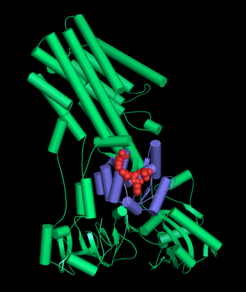News from the Mailroom of the Cell
Max Planck Researchers elucidate important mechanism of protein transport
Cells in an organism communicate with each other via messenger substances. These are often proteins such as hormones, which after their production inside the cell are transported out of the cell and secreted to the cellular environment. How exactly this export process takes place in detail has until now remained unclear. Researchers at the Max Planck Institute of Biochemistry (MPIB) in Munich-Martinsried have now shown in detail how the ‘mailroom of the cell’ sorts a subset of the proteins that are transported out of the cell. “This mechanism regulates the correct sorting of the proteins and is thus essential for the human organism,” said Julia von Blume, research group leader at the MPIB. The results have now been published in the Journal of Cell Biology.

Structural model of the human calcium transporter SPCA1: The cofilin binding domain is displayed in purple. The four residues required for direct cofilin binding are indicated as red spheres.
Similarly as we people communicate, our body cells can also exchange brief messages. For this purpose, many of them often use proteins as messengers, such as hormones. These are produced inside the cell and then packed for export in small membrane packages, the vesicles, and sent out from a kind of ‘mailroom’, the so-called Golgi apparatus. But since not all vesicles are destined for export, it is crucial that the proteins are sorted into the correct vesicles. Until now, however, it was unclear how this sorting actually works.
Julia von Blume and her team of the research group “Molecular Basis of Protein Trafficking” at the MPIB are dedicated to finding the answer to this question. In previous studies they showed that the interaction of three proteins is decisive for the sorting process. Actin, a central support and transport molecule, and cofilin, a protein complex, work together. Near the vesicles they bind the calcium transporter SPCA1, which increases the local concentration of calcium. That attracts the corresponding proteins, which are then incorporated into a vesicle and exported from the cell.
New details elucidated
In the current publication, the scientists elucidated the specific molecular mechanism underlying these steps. By investigating the individual proteins in isolation as well as in living cells, they were able to precisely decipher their interaction (down to the amino acids).
The new findings not only confirm the previous studies, but are also medically relevant: “This mechanism regulates the correct sorting of the proteins in the Golgi apparatus and is thus essential for the human organism,” said Julia von Blume, illustrating her explanation with an example: “If this process is impaired, severe health problems such as the skin disease Hailey-Hailey can be the result. It is assumed that due to a genetic defect, the calcium transporter SPCA1 does not function and therefore certain proteins that are important for cell-cell communication in the epidermis can no longer be exported from the cell.“ Patients with Hailey-Hailey disease thus suffer from discoloration of the skin, itching and blisters.
In the future, the scientists hope to clarify whether other proteins are involved in the process – always with the objective to ultimately reconstruct the entire process.
[HS]
Original publication:
C. Kienzle, N. Basnet, A. Crevenna, G. Beck, B. Habermann, N. Mizuno and J. von Blume: Cofilin recruits F-actin to SPCA1 and promotes Ca2+-mediated secretory cargo sorting. Journal of Cell Biology, September 1, 2014.
DOI: 10.1083/jcb.201311052



